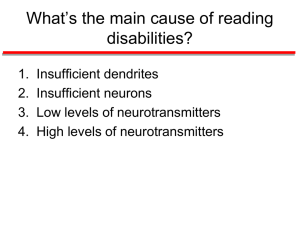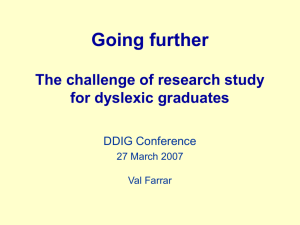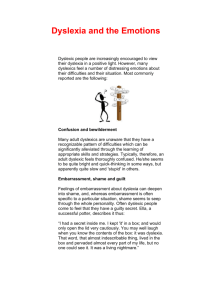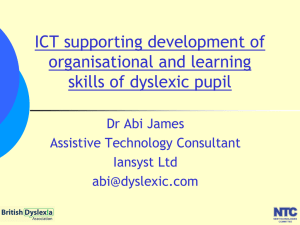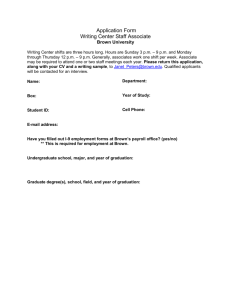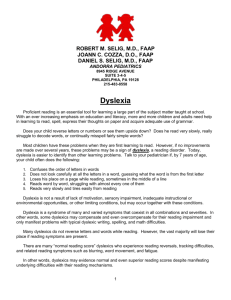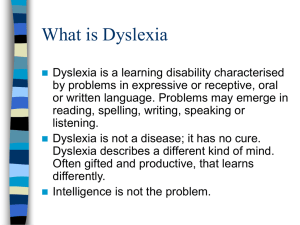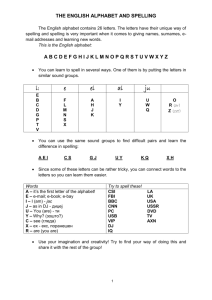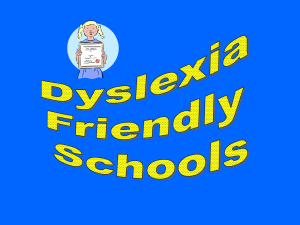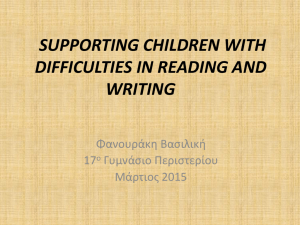Assistive-technology-Auspeld-Workshop
advertisement
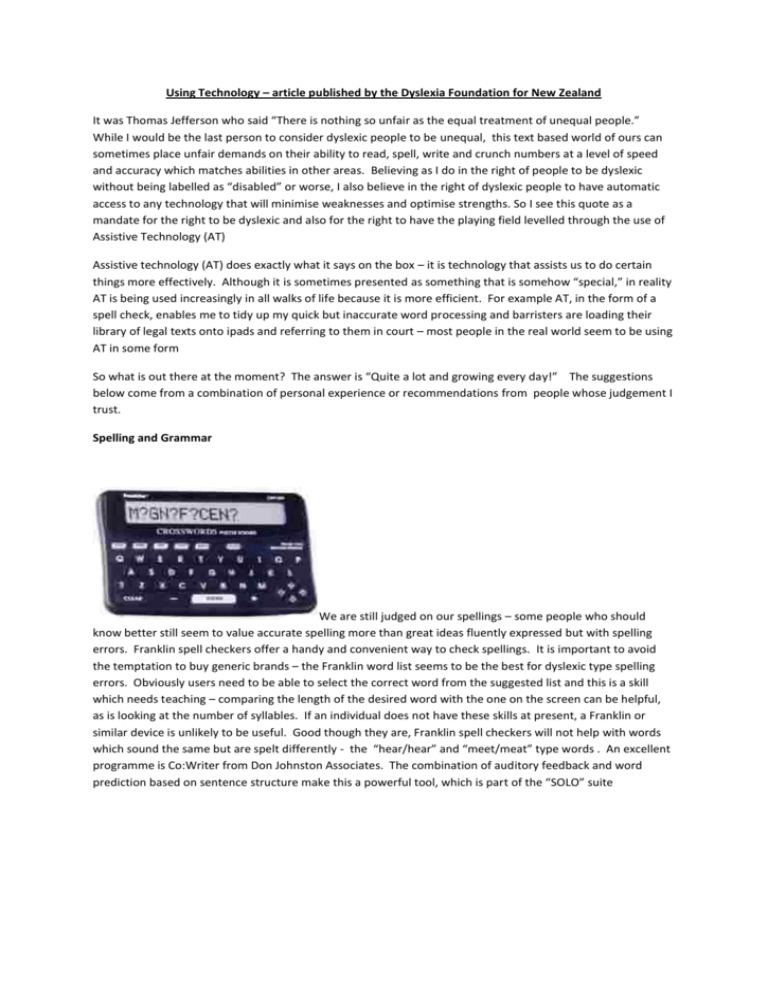
Using Technology – article published by the Dyslexia Foundation for New Zealand It was Thomas Jefferson who said “There is nothing so unfair as the equal treatment of unequal people.” While I would be the last person to consider dyslexic people to be unequal, this text based world of ours can sometimes place unfair demands on their ability to read, spell, write and crunch numbers at a level of speed and accuracy which matches abilities in other areas. Believing as I do in the right of people to be dyslexic without being labelled as “disabled” or worse, I also believe in the right of dyslexic people to have automatic access to any technology that will minimise weaknesses and optimise strengths. So I see this quote as a mandate for the right to be dyslexic and also for the right to have the playing field levelled through the use of Assistive Technology (AT) Assistive technology (AT) does exactly what it says on the box – it is technology that assists us to do certain things more effectively. Although it is sometimes presented as something that is somehow “special,” in reality AT is being used increasingly in all walks of life because it is more efficient. For example AT, in the form of a spell check, enables me to tidy up my quick but inaccurate word processing and barristers are loading their library of legal texts onto ipads and referring to them in court – most people in the real world seem to be using AT in some form So what is out there at the moment? The answer is “Quite a lot and growing every day!” The suggestions below come from a combination of personal experience or recommendations from people whose judgement I trust. Spelling and Grammar We are still judged on our spellings – some people who should know better still seem to value accurate spelling more than great ideas fluently expressed but with spelling errors. Franklin spell checkers offer a handy and convenient way to check spellings. It is important to avoid the temptation to buy generic brands – the Franklin word list seems to be the best for dyslexic type spelling errors. Obviously users need to be able to select the correct word from the suggested list and this is a skill which needs teaching – comparing the length of the desired word with the one on the screen can be helpful, as is looking at the number of syllables. If an individual does not have these skills at present, a Franklin or similar device is unlikely to be useful. Good though they are, Franklin spell checkers will not help with words which sound the same but are spelt differently - the “hear/hear” and “meet/meat” type words . An excellent programme is Co:Writer from Don Johnston Associates. The combination of auditory feedback and word prediction based on sentence structure make this a powerful tool, which is part of the “SOLO” suite Paper Rater is a free piece of software which works slightly differently but is well recommended by experts in the field – it might be a useful starting point. Listening and note taking The Echo Smart Pen by Scribe is an amazing piece of AT .It records and links audio to what a person writes using the pen and special paper and enables the user to take notes while simultaneously recording someone( e.g., a teacher) speaking. The user can later listen to any section of his notes by touching the pen to his corresponding handwriting or diagrams. . Although there will be obvious applications for older students and adults, the smartpen is so intuitive and flexible that primary school children will be able to use it effectively as well. I particularly value the opportunity it gives for students to record their ideas in a range of personalized ways and then link them to a recording of the lesson. It sounds almost too good to be true and really has to be experienced for the true power to be appreciated Using the Smartpen Optical Character Recognition This is a form of AT which allows a user to scan printed material into a computer or handheld unit. The scanned text is then read aloud via a speech synthesis/screen reading system such as Clicker 5 or Natural Reader Text to Speech (see below). Optical Character Recognition (OCR) is available as stand-alone units, computer software, and as portable, pocket-sized devices. The reading pen is a pocket sized scanner which can work really well – although it does take a bit of getting used to for some users. A word or phrase is scanned and the device reads it out. I have had experience of this in second language settings and the feedback from students is very positive. It is also possible to get talking OCR on an iphone. Dr Ian Smythe, an acknowledged expert on assistive technology for dyslexic people, is enthusiastic about “Prizmo” which is available through the App Store and offers a speech synthesis voice as an extra option. Assistive technology (AT) and maths Many of the problems my students experience with Maths are less about understanding the problem and more about setting out the sum. AT is available which supports the organization, copying and aligning of mathematical problems and processes. Getting the numbers properly aligned using pencil and paper is a major issue for many students and this technology is proving helpful especially as numbers that appear onscreen can also be read aloud via a speech synthesizer. Organisation and Memory Working memory is finally being recognised as a key element in learning how to learn. Many of my students are totally capable of performing a complicated task but struggle with remembering what comes next. These issues also impact on their personal life in terms of being in the right place at the right time with the right books and/or equipment. There are a number of AT tools which can help with organization, planning, keeping track of calendars and schedules etc. These tool support the management, storage and retrieval of key information and are easily accessed in times of stress when, a dyslexic’s working memory is not always at its best. Microsoft One Note is a free organiser which allows the user to make notes of any length and on any subject. Typing a few words from the original document enables the entire piece to be retrieved. Abbreviation expanders are proving valuable, especially when the subject matter contains complex jargon words. The programs enable the user to create abbreviations for words and phrases that are used frequently. These abbreviations are then stored and can be accessed with a few key strokes. Programs such as Active Word and Pen Friend are proving to be effective with many users. Graphic organizers Many of my students find it hard to start writing tasks because they have too many ideas and are not sure where to start. Also their eclectic thinking patterns mean that they tend not to begin at the beginning. While many conventional planning approaches require students to begin at the beginning, graphic organizers and outlining programs are sufficiently flexible to allow users to start at any point and the re-organize once the pattern or sequence of ideas has become clearer. This facility to think out of the envelope, “dump” ideas and then re-process is often a real boon for adults as well as students. Inspiration is a well-respected program, as is Kidspiration, which is for younger users – I tend to use Kidspiration for my presentations because it produces very clear and extremely flexible maps out of an often random “think, dump, re-organize” process. Both are available as free trial downloads. I have also had very positive reports about Mind Manager and Mind Genius. Assistive Technology is making a difference to the lives of countless people, many of whom are not dyslexic but appreciate ways to read, write, spell, process number and organize ideas more efficiently. The New Zealand Government has produced helpful guidelines about the availability and use of AT in schools and opportunities for use in the workplace are increasing all the time. Our challenge is to get the use of AT to be seen as a right rather than a privilege and also to make the technology easily available and affordable so that the right of access is independent of income or opportunity. Copyright Neil MacKay March 2012
